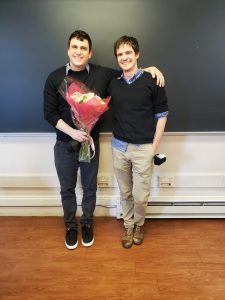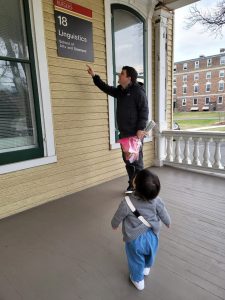We’re really pleased to announce that Nate Koser successfully defended his dissertation on March 30th, 2022!
Title: The Computational Nature of Stress Assignment
Committee: Adam Jardine (Chair), Bruce Tesar, Adam McCollum, Jeffrey Heinz (Stony Brook University)
Abstract: This dissertation articulates a restrictive theory of stress based on formal language theoretic complexity. It demonstrates that stress patterns that appear more complex as a single step from input to output can be profitably broken down into less-complex stress primitives or “atoms” that combine to derive the observed surface pattern. Though the idea that surface stress patterns are the combination of more fine-grained generalizations is not new, the theory proposed here uses independently motivated categories from computational complexity to provide a well-defined notion of the nature of these generalizations and the exact computational power at which they operate. An assertion regarding computational power is a hypothesis as to why stress patterns take the form that they do – they are beholden to certain computational restrictions that limits the range of patterns that may be defined. Thus, defining the formal properties of stress atoms provides a metric for evaluating what an attested stress pattern can be, improving the predicted typology.
This dissertation models stress as a string-to-string mapping from input to output, where the input is a bare string of syllables and the output is marked with stress. Patterns which are formally more complex when viewed as a single function break down into atoms corresponding to much simpler function classes. Iteration of stress is handled by a single output strictly local function (OSL; Chandlee 2014; Chandlee and Heinz 2018), while other stress properties such as non-finality are handled by an “edge-oriented” (EO) function, a novel function class defined in this thesis. EO functions encode the fact that stress generalizations such as non-finality are tethered to a word edge, and thus provide a restriction based on substantive stress properties couched in computational terms. Long-distance patterns break down into combinations of EO and strictly piecewise functions (SP; Rogers et al. 2010; Burness and McMullin 2020), which characterize long-distance processes without the overgeneration of more complex function classes. The stress component of the phonological grammar is thus comprised of atoms that are maximally OSL, EO, or SP, which are composed in a specific sequence. This hypothesis on the computational nature of stress is expressive enough to describe attested patterns, but sufficiently restrictive to eliminate many patterns that are logically possible but non-phonological, such as patterns that require explicit parity counting.
_______
Congratulations Dr. Koser!!
Here are some pictures from the day!

